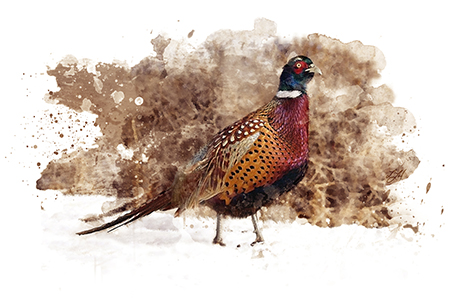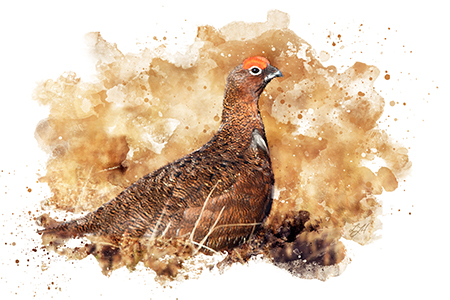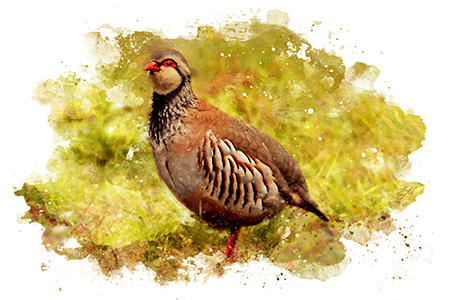The Ultimate Guide To British Game Birds

Since we host such a vast array of game bird, it can be easy to forget which is which. To keep things simple, we’ve created this handy guide to British game birds. Let’s look at each type of bird in more detail…

Pheasant
Pheasants were introduced to Pembrokeshire, Wales from southern Ireland in the 17th century, and have been a mainstay of the hunting community ever since.
Scientific name: Phasianus colchicus
Did you know? The pheasant is by far the most well-known and abundant game bird in Britain and is a staple of driven shooting. There are approximately 35 million released in the UK every year.
Characteristics: Pheasants are large, long-tailed gamebirds. Males have a deep green head and red face, with deep chestnut, golden and black marks on their bodies and tails. Females, on the other hand, are speckled paler brown and black.
They are approximately 53-89cm in length, with a wingspan of 70-90cm. Males typically weigh 1,000-1,700g, and females are 750-1,200g. With a subtle flavour, pheasants are a great choice for those taking their first plunge into the world of game shooting.
Diet: Adult pheasants will eat just about anything! They enjoy seeds, grain, insects, oats and even the controversial sprout.
Season: October 1st – February 1st (England, Wales & Scotland); October 1st – January 31st (Northern Ireland). Check out our seasonal shooting calendar for more information on the various shooting seasons.
Where: Pheasants are typically spotted in the open countryside in woodland edges, shrubby wetland, copses and hedgerows. You can find them across of the UK, though the Devon and Welsh hills are known for providing the best experiences.
Top tips on how to hunt them:
- Know the breed of pheasant you’re shooting – Each breed of pheasant has different characteristics, such as their size, speed and manoeuvrability in certain conditions. Anticipate how your breed will behave in flight and give yourself a head start.
- Keep the noise down – Pheasants have an excellent sense of hearing, which they use to detect their predators. When they feel vulnerable, they’ll stoop low or hide under thicker cover. If you need to talk to your shooting partner(s), do so quietly or use gestures to communicate.
- Time is not of the essence – If you move too quickly through the cover, you risk being outsmarted by a pheasant, as it will circle behind you back to safety. Take your time and zigzag through cover. Frequent pauses for a moment or two will fool the pheasants into thinking it’s safe to take to the skies. Once this happens, don’t rush your shot –set yourself up properly.
- Move your feet –You’ll limit the rotational movement in your body if you don’t have your feet in the right place. Your feet should move depending on the bird’s motion in flight. So, for those with two left feet, make sure your footwork doesn’t let you down.
- Treat yourself to a lie-in – The ‘start early, finish early’ mindset isn’t as great as you may think. In fact, you could be missing the best time for hunting. When pheasants get peckish during the last hour of daylight, they come out of heavy cover and head to more open roost sites –so don’t put your feet up too early.
- Chill out – If you’ve not bagged a rooster early on, don’t be discouraged. Perch yourself down and take a break. It might be a case of letting the pheasants come to you, or slowly working through all the cover in an area. Stay patient, even when the going gets tough.
Best locations: Choosing the next location for your shoot can take a while. You might be none the wiser even after spending a few hours on Google or asking around for advice.
However, there are plenty of famous shooting locations to choose from, such as Castle Hill in Exmoor or the magical Alnwick shoot or the Cheviot Hills.

Black Grouse
Scientific name: Lyrurus tetrix
Did you know? One of the most amazing wildlife spectacles of the year is the annual Black Grouse Lek, where the males strut around in a traditional area and make a distinctive, extraordinary mating call during their annual courting ritual. Find out more about the spectacle here – and if you want to see this for yourself, it takes place between March and April.
Characteristics: The black grouse is a large game bird. Males have black plumage with red wattles, a white wingbar and a lyre-shaped tail, which is fanned out to portray white under-tail feathers when displaying. The female is a greyish-brown colour with a slightly rough tail. The black grouse is a large bird – males are around 53 cm long and weigh 1,000–1,450 g, while females are approximately 40 cm and weigh 750–1,110 g.
Diet: The black grouse lives off buds, berries, catkins and shoots.
Season: August 20th – December 10th (England, Wales & Scotland); September 1st – December 10th (Somerset, Devon & New Forest)
Where: Black grouse are often found in upland areas of Wales, the Pennines and the majority of Scotland. They’re most commonly seen on farmland and moorland with nearby forestry or scattered trees.
Top tips on how to hunt them: If you’re new to game shooting and need a few useful pointers, check out our top tips on How to Bag Your First Grouse.
Best locations: Here’s a selection of Britain’s best grouse moors:
- Undoubtedly one of the best grouse moors in the country is Bollihope in Durham. It features amazing upland surroundings and is one of the UK’s most exclusive grouse shooting locations. If you’re lucky enough to get invited, make the most of it!
- Milden in Angus is a great sporting estate, parading challenging Scottish grouse in their prime.
- Gunnerside in Yorkshire contains magnificent challenging grouse and hosts an incredibly professional team of keepers and organisers.
Glenbuchat in Aberdeenshire is another great location. It’s a fun two-day moor with beautiful, sweeping views over the nearby estates, top hospitality, a homely lodge and an incredible head keeper.

Red Grouse
Scientific name: Lagopus lagopus scotica
Did you know? While pheasant is the most well-known game bird, those who are well accustomed to the world of game know red grouse is the crème de la crème of British game birds. This is not just because of the grouse’s delightful flavour and low-fat content, but because it’s unique to the British Isles.
People from all over the world pay large amounts of money to shoot grouse, because younger grouse that are bagged at the start of the season tend to be leaner, more tender and more flavoursome.
Characteristics: The red grouse is a medium-sized game bird. It has reddish brown plumage, with a short black tail and white legs. They also have white stripes on the underwing and red combs over their eyes. They are approximately 37-42cm in length, with a wingspan of 55-66cm and around 650-750g.
Diet: Mainly the shoots, seeds and flowers of heather, berries and sometimes insects.
Season: August 12th – December 10th (England, Wales & Scotland); August 12th – November 30th (Northern Ireland). The grouse shooting season starts off the Glorious Twelfth (August 12th),the most monumental date in the shooting calendar. This marks the start of the shooting season as a whole and continues all the way through to December.
Where: The grouse is endemic to the British Isles and can be found across Scotland, Ireland, Wales and England (mostly the North). The best place to look for the grouse is on upland heather moors away from trees, but they can also be seen in some low-lying bogs and occasionally on farmland.

Partridge
There are two types of partridges – red-legged and grey. Red-legged partridges are bigger than their grey counterparts and were introduced to Britain from Spain and France. As the grey partridge’s numbers have declined and are harder to come by, the red-legged partridge now accounts for most of the UK’s partridge shooting.
The grey partridge, although rarer, is considered superior in texture to the red partridge. However, whichever species you try, you’ll still enjoy delicate meat without an overly strong gamey flavour.
Grey partridge
Scientific name: perdix perdix
Did you know? Also known as the 'English partridge', the grey partridge lays the largest number of eggs of any bird – in some place, up to 19 eggs can form a clutch!
Characteristics: The grey partridge is a plump, round, medium-sized bird with a brown back and grey flanks and chest. It’s face is a burnt orange colour, with a white belly that is sometimes marked with a large brown ‘horse shoe’ shape. They’re approximately 30cm long, with a wingspan of 46cm, and usually weigh around 390g.
Diet: They tend to eat leaves, seeds and insects.
Season: September 1st – February 1st (England, Wales & Scotland)
Where: The grey partridge is becoming rare around vast areas of the country. It’s often found in lowland arable areas of Great Britain and the east of Scotland, but is almost non-existent in Northern Ireland. Its home is wasteland, moors and sand dunes.
Red-legged partridge
Scientific name: Alectoris rufa
Did you know? The red-legged partridge is unusual, in that the female may build two nests, lay a clutch in each and then the male and female take care of each brood simultaneously and independently., When disturbed, it prefers to run instead of fly, so be aware of your foot position when making an approach..
Characteristics: The red-legged partridge, sometimes known as French partridge, is larger than the grey partridge. It’s a plump bird with a light brown back, grey breast and white face with a black gorget and red legs. Furthermore, it’s approximately 32-34cm in length, with a wingspan of 47-50cm and a weight of 400-550g.
Diet: Red-legged partridges have a similar diet to the grey partridges, often eating leaves, seeds and roots. However, the younger partridges usually eat insects.
Season: September 1st – February 1st (England, Wales & Scotland)
Where: Red-legged partridges are mainly found in England, particularly in the east, and can also be found in the Welsh borders and eastern Scotland. They are often seen in groups in open fields, such as dry lowlands, farmland, grassland and heathland.
Top tips on hunting partridges: Although partridges are a pleasure to shoot, they can be deceiving – so good technique is a must. Here’s some top tips to send you on your way:
- Choose fellow guns who share your passion for the sport and recognise a good bird.
- Partridges are relatively small birds, so they do not require large shot sizes or extreme payloads. Sub-1oz (24g or 25g) of 6 shot will suffice and won’t put too much pressure on the shoulder.
- Shooting them successfully requires a grouse-like approach. Carry the gun at high port and be prepared to address the group as they present themselves.
- When they get to a safe height, the birds should be taken as far in front as you can, which needs quick action.
- Do not over-swing for the second partridge – keep an eye on the sky.
- Always return your feet to the centre once you’ve moved them.
Our top 5 partridge shooting locations:
- Quidenham, Norfolk – Cosy lodge, plenty of partridge over hedgerows, 50 drives available and sufficient options for all types of weather conditions. A must.
- Drumlanrig, Dumfries and Galloway, south west Scotland – One word – windy. You better get some practise in before you attempt this terrifying but thrilling shoot.
- Gurston Down, Wiltshire – Steep terrain ensures the birds are always high. There’s also incredible knowledge and expertise from the team on the ground.
- Belvoir Castle, Leicestershire – Treat yourself to a stay in the castle,, where you can enjoy the state bedrooms, fine wines, warm fires, and dinner in the Duke and Duchess’s private quarters.
Molland, Devon – On the edges of the stunning Exmoor National Park and perfect for the high bird enthusiast.

Common Snipe
The common snipe is a widespread breeding species in the UK but the population has dropped slightly in the last 25 years, owing to declines in lowland wet grassland.
Scientific name: Gallinago gallinago
Did you know? Unlike the other game birds on our list, the snipe bird is cooked and roasted whole, with the innards still inside. Winston Churchill enjoyed a couple for his breakfast, washed down with a copious amount of port. While this process isn’t for the faint-hearted, it really adds to the flavour of the final dish and snipe pâté is particularly tasty.
What’s more, the amazing and unique sound of the drumming or bleating of a snipe is surprisingly created by the vibration of their tail feathers as opposed to their vocals. It’s used by the males as part of their courtship ritual –listen for it on early spring mornings, or get a flavour here.
Characteristics: Snipes are medium-sized, skulking wading birds with short legs, long slender bills and a camouflage plumage. Both females and males are speckled brown above, with paler buff stripes on the back. They are typically 23-28cm in length, with a wingspan of 39-45cm, and they weigh 80-120g.
Diet: Small invertebrates, including worms and insect larvae
Season: August 12th – January 31st (England, Scotland & Wales); September 1st – January 31st (Northern Ireland)
Where: There are large concentrations of snipe on northern uplands, but fewer in southern lowlands (particularly south west England). They are usually found in moorland and well-vegetated wetlands, though the UK population of snipe has declined over the past 25 years, largely in lowland wet grassland.
Top tips on how to hunt them:
It’s incredibly tricky for hunters to catch a snipe as it flies, due to its erratic zig-zag flight pattern. This is designed to flee its predators, the peregrine and merlin, and when the snipe believes the threat has gone away, its flight is more linear. That leads us on to our first top tip…
- If you fail to conceal your gun, you’re making things harder for yourself. If a snipe believes there is no danger, it’s more likely to fly relatively straight, making shooting much easier.
- Often, a snipe will appear as little specks in the distance, and you’ll assume it’s too high. But in fact, when it’s straight above your head, it’s hardly ever out of range.
- This might sound obvious, but it’s important to keep quiet and listen to the alarm call of the bird rising.
- Don’t second guess. Success comes to those who shoot immediately without wavering.
- Mark fallen birds carefully. Snipe are particularly tough for dogs to scent, and their small size and camouflage plumage makes them difficult to find. It helps to walk towards the fallen snipe whilst keeping your eye on the mark.
Top locations: Popular snipe shooting spots include Norfolk, Suffolk and Kent. In Kent, you’ll find one of the oldest estates, Morghew Park. This offers regular opportunities to shoot snipe and is known for its friendliness and hospitality, ship-shape agricultural operation and exquisite unspoilt views. Glemham Hall in Suffolk is another popular location, covering 3,600 acres and offering great opportunities to find the common snipe, as is Saltersgate shoot in County Durham.

Mallard
The Mallard is the ancestor of nearly all domestic duck breeds (apart from the Muscovy Duck).
Scientific name: Anas platyrhynchos
Did you know? The mallard is the largest species of wild duck in Britain, so it’s usually the one you’ll be served in restaurants!
It’s lean and has a distinctively rich, gamey flavour. As such, it’s a great winter meat which goes extremely well with fruits such as orange and cherries. However, be prepared to have to use clever tactics such as decoys and duck calls to lure them out of their village ponds - they’re very cautious.
Characteristics: The mallard is a rather large and weighty looking duck, with a long body and broad bill. The male has a dark green head, grey body, purple/brown breast and yellow bill, whereas the female is mostly brown with an orange bill. They are approximately 51-62cm long, with a wingspan of 81-98cm, and they weigh around 750-1500g.
Diet: They eat seeds, acorns, berries, plants, insects and shellfish
Season: Inland September 1st – January 31st ; Below High-Water Mark September 1st – February 20th (England, Scotland & Wales). Inland September 1st – January 31st; Below High-Water Mark September 1st – January 31st (Northern Ireland)
Where: There’s a chance you’ll see the mallard wherever there’s the right habitat, such as wetlands, and marshes to ponds and rivers.
- Top tips on how to hunt them: Know when the flight is – watch online weather maps until you’ve got meteorology coming out your ears. Note down where night-time temperatures are between 0C and -10C, as this is when shallow waters will freeze. You can also watch the snow line, because once corn or soybeans are covered, the mallards will move south towards exposed food sources. Alternatively, get the heads up from friends or landowners who live further north of you along the flyway.
- Use less decoys – choose quality over quantity and use your money for higher quality decoys. Migrating ducks will have seen plenty of shiny, painted decoys, so choose the most realistic ones.
- Add better decoys – Mallards trust geese, so by including some Canada goose decoys, you’re onto a winner.
- Choose the right water – Before the freeze, target little, isolated pockets such as forgotten backwaters. These are the types of protective shelters migrating mallards are searching for. When they freeze, take to the river.
- Choose the right field –The mallards need lots of high-carb grain forage for their journey, so if you find a hot field then you’re in luck.
Top locations: From the Dorset Wildfowlers at Poole Harbour to the famous Dee Estuary on the west coast, there are plenty of wildfowling locations in the UK.

Woodcock
The Woodcock is a large, bulky bird with short legs. It is mainly nocturnal and will spend most of the day hidden by dense cover.
Scientific name: Scolopax
Did you know? Woodcocks are considered one of the most sporting game birds, due to their zig-zagging flight – much like the common snipe. The similarities don’t stop there – woodcocks are also cooked without having their head, feet or organs removed, which complements the flavour of the final dish. Woodcock meat can be extremely hard to get hold of due to Britain’s declining Woodcock population. However, if you do get hold of them, it’s certainly worth the effort.
Characteristics: The woodcock has a stocky body, with brown and black plumage, short legs and a long thin bill. It is approximately 33-35cm in length, 240-420g in weight and has a wingspan of 55-65cm. They also have 360° vision, because their eyes are located on the sides of their heads.
Diet: Woodcocks eat in the evening or at night, searching for worms, beetles, spiders, caterpillars, fly larvae and small snails. As they’re basically nocturnal, they spend most of the day in dense cover.
Season: October 1st – January 31st (England, Wales & Northern Ireland); September 1st – January 31st (Scotland)
Where: They can be found in suitable habitat in summer throughout the UK, apart from south-west England. In winter, they’re prevalent in lowland areas. It takes some luck to see one, but you might unintentionally disrupt one from its resting place (often woodland and farmland) and catch it zigzagging through the trees and plummeting back into cover.
Top tips on how to hunt them: The population of British woodcock is now so imperilled that many game-shooters choose not to shoot them until the population revives. Charles Pinckney, a lifelong field sportsman and chairman of The Woodcock Trust, states: “these incredibly special and beautiful birds are in real trouble” and believes shooting woodcock should not resume until there are at least 100,000 breeding males. But when the times right, you can head over to look at our five tips to help you bag this most elusive game bird.
To find out more about game birds, as well as mammals and waterfowl, visit out interactive shooting calendar! Regardless of which type of shooting you do, before you head out on a shoot, it’s important to make sure you’re fully protected with specialist shooting insurance.




